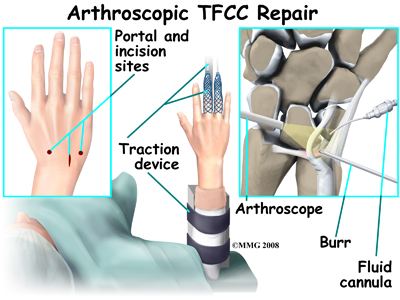If you have suffered a TFCC tear, you know how painful and debilitating it can be. Not only is the injury itself painful, but the healing process can be slow and frustrating. Many people are unsure of how to treat TFCC tears, which can lead to further complications. In this blog post, we will discuss the best TFCC tear treatment protocol. We will also provide tips for speeding up the healing process.
Contents
Understanding Triangular Fibrocartilage Complex Tear(TFCC)

The Triangular Fibrocartilage Complex (TFCC) is triangular-shaped cartilage located on the ulnar side of the wrist. The TFCC acts to stabilize the ulna during pronation and supination of the forearm and also functions as a shock absorber between the ulna and carpal bones.
Most TFCC tears are degenerative in nature and occur with repetitive motion or trauma to the wrist. However, some TFCC tears can also be caused by rheumatoid arthritis or other inflammatory conditions.
Types of TFCC Tears
There are two types of TFCC tears. They are as follows:
1. Radial tear: This is the most common type of TFCC tear. It occurs when the outer part of the TFCC has torn away from the bone.
2. Ulnar tear: This type of TFCC tear is less common. It happens when the inner part of the TFCC has torn away from the bone.
Causes of TFCC Tears
There are several things that can cause a TFCC tear. They are as follows:
1. Trauma: A fall or direct blow to the arm can cause a TFCC tear.
2. Degenerative changes: These are changes that occur in the tissue with age.
Treatment Protocols

There are several different ways to treat a TFCC tear. They are as follows:
Rest
This is the first step in treating a TFCC tear. You will need to rest your arm and avoid any activities that put a strain on the wrist. For example, don’t lift anything heavy or play any sports that require using the arm and wrist.
Ice
Apply ice to the affected area for 20 minutes at a time, several times a day. This will help reduce swelling and pain. For instance, if you think your pain is coming from a trigger point in your subscapularis muscle, you can place an ice pack on that area for 20 minutes at a time.
Heat
After the initial swelling from the TFCC tear goes down, you can apply heat to the affected area to help loosen and relax the muscles and tendons. Heat can be applied using a warm, wet towel or heating pad set on low.
Elevation
Keeping the affected arm elevated above heart level will also help reduce swelling. For instance, you could prop your arm up on a pillow while you sleep.
Compression
Use a wrist brace or wrap to compress the area and stabilize the joint. For instance, you can wear a splint at night to keep your wrist from moving. If the pain is severe, you might need a sling to keep your arm from moving.
Anti-inflammatory medication
Take over-the-counter anti-inflammatory medications, such as ibuprofen or naproxen, to help reduce swelling and pain.
Corticosteroid injections
Injections of corticosteroids into the affected joint can help reduce inflammation. For example, an injection into the wrist may be used to treat a TFCC tear in that area.
Surgery
Surgery may be needed to repair a large tear or one that does not heal with nonsurgical treatments. The type of surgery performed depends on the size and location of the tear.
- Arthroscopy: Arthroscopy is a minimally invasive surgical technique in which an instrument called an arthroscope is inserted into the affected joint through a small incision. The arthroscope has a light and camera attached to it, which allows the surgeon to see the inside of the joint. Once the surgeon visualizes the tear, he or she can repair it with small instruments inserted through other incisions.
- Open surgery: Open surgery may be needed if arthroscopy cannot be used or if the tear is large. During open surgery, the surgeon makes an incision over the affected joint and directly visualizes the tear. He or she then repairs the tear with sutures (stitches) or other fixation devices.
After surgery, you will likely need to participate in a rehabilitation program to help regain strength and motion in your affected arm or hand.
Rehabilitation
After either nonsurgical or surgical treatment, rehabilitation is important. A physical therapist can design a program to help regain strength and motion in the affected arm or hand.
Physical therapy
After your injury has healed, you will likely need to undergo physical therapy to regain strength and range of motion in your wrist. It includes:
- Wrist exercises
- Manual therapy
- Ultrasound
- Electrical stimulation
Your physical therapist will likely also recommend a home exercise program for you to do on your own to help supplement your therapy.
Occupational therapy
In some cases, occupational therapy may also be necessary to help you regain the full function of your wrist. For instance, you may need to learn new ways to perform your job or daily activities.
No one treatment protocol is right for everyone. Your doctor will work with you to determine the best course of treatment based on the severity of your TFCC tear and your overall health.
Conclusion
It may be concluded that TFCC tear treatment protocol by means of arthroscopic debridement and/or repair is an effective approach to relieving pain and improving function in patients with TFCC tears. It is a minimally invasive procedure with a low risk of complications. In addition, this treatment option can be performed on an outpatient basis, which is convenient for patients.
If you have a TFCC tear, talk to your doctor about the best treatment option for you.
Physical Therapy help patients recover from pain. If you’re experiencing Back pain, Shoulder pain, Knee pain, Neck pain, Elbow pain, Hip pain, or Arthritis pain, a physical therapist at MantraCare can help: Book a physiotherapy session.


